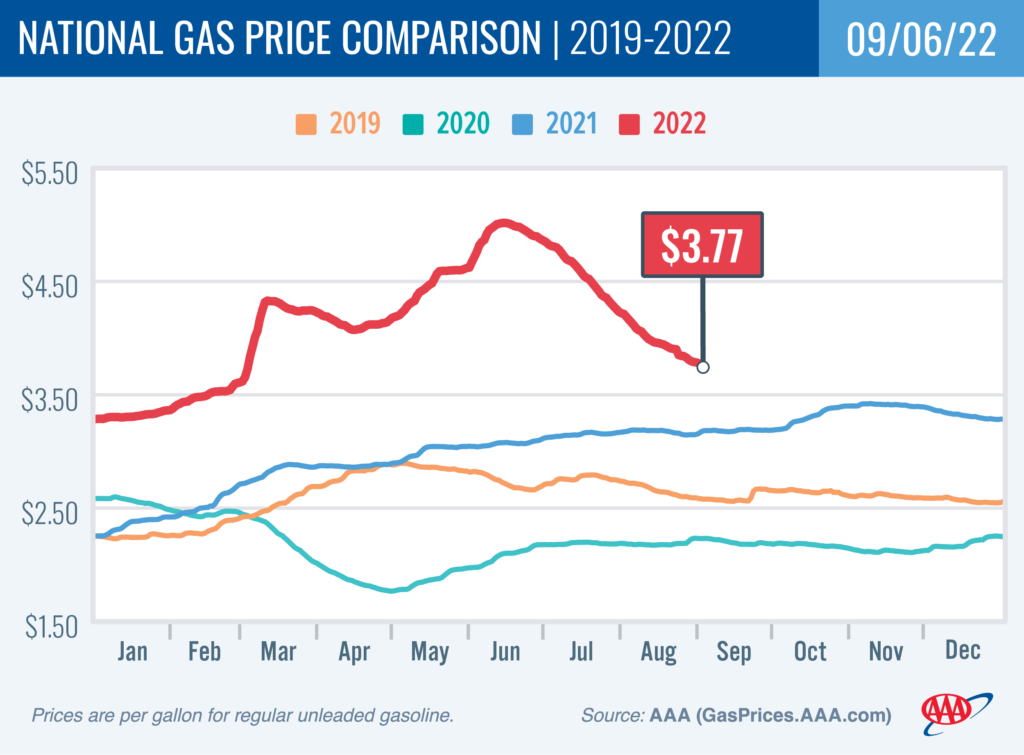
WASHINGTON, D.C. (September 6, 2022)—Lower oil prices, modest domestic gasoline demand, and a quiet hurricane season are combining to drive pump prices lower. The national average for a gallon of gas fell seven cents in the past week to $3.77.
“According to weather analysts, it’s the first time in 25 years that a named Atlantic storm did not develop in August. That’s the good news,” said Andrew Gross, AAA spokesperson, “but we still have another month of peak hurricane season, and these storms can affect gas prices by disrupting oil production and refining.”
Meanwhile, oil prices dipped on recent lackluster Chinese manufacturing output due to lower demand for goods and new COVID‑19 outbreaks in critical industrial cities. This is fueling fears that oil demand could drop in China, the world’s largest importer of crude oil.
According to data from the Energy Information Administration (EIA), domestic gas demand increased slightly from 8.43 million b/d to 8.59 million b/d last week. However, the rate is nearly 1 million b/d lower than the last week of August 2021. Also, total domestic gasoline stocks decreased by 1.1 million bbl to 214.5 million bbl. Although gasoline demand rose and supply tightened, lower oil prices led to falling pump prices. If oil prices continue to decline, drivers will likely continue to see pump prices drop further.
Today’s national average of $3.77 is 31 cents less than a month ago but 59 cents more than a year ago.

Quick Stats
The nation’s top 10 largest weekly decreases: Vermont (−15 cents), Connecticut (−14 cents), Rhode Island (−14 cents), Pennsylvania (−14 cents), Massachusetts (−13 cents), Maine (−13 cents), New York (−12 cents), Delaware (−12 cents), New Jersey (−12 cents) and Maryland (−12 cents).
The nation’s top 10 least expensive markets: Texas ($3.25), Arkansas ($3.25), Mississippi ($3.26), Louisiana ($3.30), Georgia ($3.31), Oklahoma ($3.34), Tennessee ($3.36), Missouri ($3.36), Alabama ($3.37) and South Carolina ($3.39).
Oil Market Dynamics
At the close of Friday’s formal trading session, WTI increased by 26 cents to settle at $86.87. Crude prices increased slightly at the end of last week due to the Organization of the Petroleum Exporting Countries (OPEC) and its allies, collectively known as OPEC+, deciding to reduce production by 100,000 barrels for October. However, prices declined most of last week amid market concerns that crude demand will fall if economic growth slows or stalls due to a recession. For this week, crude prices could continue to drop if demand concerns persist. Additionally, EIA’s latest weekly report showed that total commercial crude inventories decreased by 3.4 million bbl to 418.3 million bbl.
Drivers can find current gas prices along their route using the AAA TripTik Travel planner.
###
